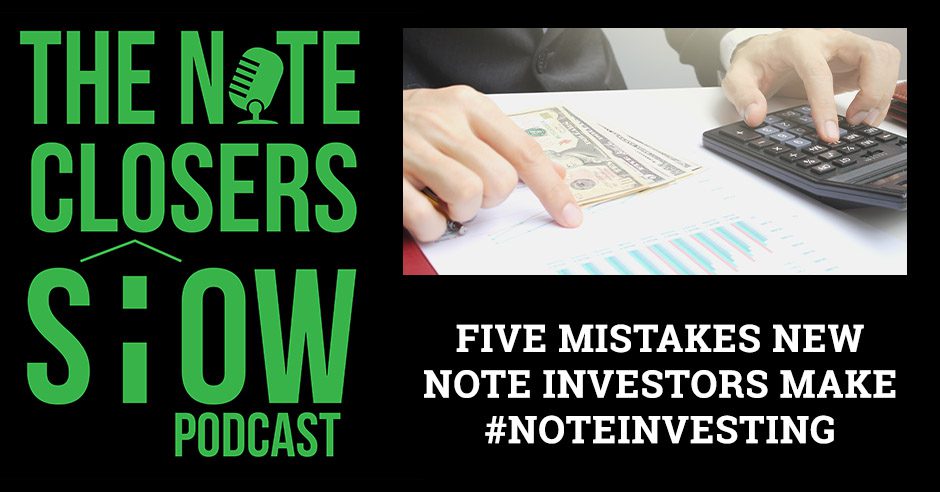
Mistakes are possible, especially when you are a first-time note investor—many don’t want to take risks for fear of making mistakes and losing a sum of money. But you don’t have to let fear stand between you and success. In this episode of the Note Closers Show Podcast, Scott Carson shares the five common mistakes new note investors make when diving into nonperforming notes. In this industry where buyers and sellers change, you have to constantly buy and keep track of what’s going on in the industry, so tune in to this conversation and hear more from Scott Carson.
He discusses the mistakes that investors make with
1) The Property vs. the Note
2) Note Time Frames
3) Note Pricing
4) Note Strategy
5) Money & Marketing
—
Watch the episode here
Listen to the podcast here
Five Mistakes New Note Investors Make #Noteinvesting
I’m excited to be here with you. In this episode, I want to focus on five mistakes I see people new to the note industry making. It’s not their fault that they’re making the mistakes because, for the most part, they’ve developed these skills either as a real estate investor or learning the property side of real estate, “I’m going to go out and buy a property. I’m going to go flip a home, buy an REO, or buy a rental property.” They’ve had this ingrained, or they’ve watched TV and all those fictional shows on HGTV, Flip This House or Flip or Flop, and think of what they’re going to get.
Buying The Note, Not The Property
The number one mistake that we see note investors make is the fact that they’re buying the note, not the property. The property is collateral for the note. The debt controls the property. When you buy a note, you don’t immediately get to take over the property. If the borrower has signed the property back to the bank for the lender, which is when you buy the note and you become a lender, then you can take it over.
If they have left the property, you can go in and change the locks to secure your investment. If it’s a vacant property, you can secure it, but that doesn’t mean rehab it and start doing all this stuff. You still have to go through that legal process of foreclosure to enforce your position to be able to take the property back in foreclosure and deed of loan or offer the borrower cash for keys or something like that. That’s the number one thing.
People think, “I’m buying the property.” You’re not buying the property. You’re controlling the property by buying the debt or the note. That’s why it’s important. Make sure you know what you’re buying and that it’s a first lien because that’s all we buy. You can buy a junior lien if there’s plenty of equity and you’re getting a good price, but we like to stick to first lien investing because then the only thing you can wipe us out is taxes or an act of God.
How do you protect yourself from an act of God? Insurance. How do you check taxes? Go to the county recorders or accounting tax off, pick up the phone, and ask them to find out what’s going on. That’s also an important thing to be when you’re buying the note. If the borrower decides to start to pay what they’re due and reinstate the loan, they have that right to do. We’ve seen investors like, “We think the borrower is going to go ahead, walk away, and will foreclose, so we’re going to pay a higher price for that note.”
Lo and behold, what is the borrower due? They reinstate, and the investors left with a lower ROI than what they would’ve normally done. That’s the thing. You also got to be careful about buying the notes. You’re not going to get access to the property. You want to be very specific and careful, especially if you’re buying in a longer foreclosure state like New Jersey or New York, where it can take 2 to 3 years to foreclose.
You need to know what’s going on and what the lender’s rights are in any particular state. It is also important if you’re going to foreclose. What’s the eviction timeframe if the borrower is not going to walk away? That’s why it often sometimes makes sense to offer cash for keys to help expedite this versus dragging this out. You don’t end up with a property when you buy a note, not all of the time. If it’s vacant and you’re foreclosing, you can end up with that, but if there’s a ton of equity, that borrower is going to fight you for that asset.
Note Time Frames
This takes us to the second mistake that we see new note investors make. Many of them come in like, “I’m going to buy a property. I’m going to flip it and be in and out of it in 90 days.” That’s not the case with note investing. There are very few note deals that you’re in and out of in less than a year. If you’re buying in Texas or Georgia, those are fast foreclosure states where you can buy the note, foreclose and then be in and out in six months or less. If it’s an occupied asset, people can file bankruptcy to drag it out. You got to make sure you’ve got clean paper. You’ll buy the note. You don’t end up with the property immediately. You’ve got to go through that foreclosure process, and that foreclosure process will vary on a state-by-state basis.
If a judicial foreclosure, it’s going to be at least six months or longer. If it’s non-judicial, it can be anywhere from 30 days to roughly about 5 months, depending on what state’s located. You have to look at what’s going on with the borrower. We ran into trouble during COVID when the Federal government stopped foreclosures, so you could not foreclose for years. It’s a different timeframe than going out and buying a physical asset. The offset of that is that you’re usually buying notes a lot cheaper than you’re buying real estate.
We all know real estate has been peak, and people have been overpaying for real estate wanted cases. It’s been harder to find foreclosures. One of the valuable things is that since we do have that timeframe before we pick the property back, we’re usually buying below 70% of the as-is or fair market value, depending on what the debt is owed on it. We’re getting a bigger discount because we do have to hold onto that asset for a longer time.

Note Investor Mistakes: We’re getting a bigger discount because we have to hold onto that asset for a longer time.
The great thing is that sometimes you’ll get the borrowers back on track. We’ve had borrowers that, in two weeks, were ready to reinstate. They were ready to start making payments and modify the loan, start paying time again before the servicing of that note was transferred from the old servicing company to our servicing company. It was great.
We bought the note and became the lender, but there’s a transition period of at least 2 weeks, sometimes 30 days. It takes place from the old lender servicer to transfer to your servicing company to start the collection process. That doesn’t mean you can’t talk to the borrower for 30 days. It doesn’t mean you can’t set up trial payment plans. You can’t accept the payment until the actual servicing is transferred over to you. That’s a whole different thing, but that’s a number thing.
The timeframe’s different. For most fixed and flippers, if they’re taking out money, we’ll talk more about the money difference. To get a traditional piece of property, it’s a hard money loan that may be 6 or 12 months, usually most or less, or they’re able to go get finance. With the note investing side, you have to plan on it at least being 12 to 24 months, sometimes 36 months, and the longer foreclosure states out there. It’s still short-term.
When people think of note investing, they think of 30 years. That’s another mistake a lot of people get into it, “I’m going to be tied into this deal for 30 years.” That’s not the case. We talk short-term. Our short-term is usually 12 to 36 months. That’s long-term if you’re an active fix and flipper or money lender that you want to lend money out and make points every time. This is why it’s important to raise capital.
Note Pricing
The first mistake is people evaluating just the asset for the property. They’re getting the property back versus it being the notes aspect of things and evaluating their ROI based on the note return versus flipping the property. The second thing is that the timeframe takes a little longer. The third thing is pricing. If pricing is different for performing notes than non-performing notes, you cannot apply what you’re used to as far as your pricing model coming from the fixed and flip for the property side and apply that to your note investing side. You will get burned.
I’ve seen this happen many times where a fix and flipper or a realtor gets in the note space and they’re like, “That property’s worth $200,000 after repairs. I’m going to offer $0.70 in a dollar for that.” They’re offering $140,000. Maybe only a 100 is owed. You don’t want to pay $40,000 above what’s owed. There’s no reason for that. You also have to realize that you may end up with a note, not the property. You have to evaluate your pricing based on if the borrower is going to reinstate, not reinstate, or modify the loan.
You got to know what’s going on with that asset. What are your possible strategies? This is why we’re always looking at especially occupied assets. We look to see what it would be to reinstate. We modified and then, three, if we have to foreclose, what’s this going to look like? This is why as a note investor, you need to understand all three of those strategies because it will end up happening.
We’ve had deals that we thought were going to foreclose that they end up getting modified and brought money to the table to reinstate. We’ve also had deals that we thought would modify reinstate that we ended up having to foreclose on. You have to understand. You’re buying the debt, the debt controls the property, and you have to know what that debt looks like.
It’s the same thing. Let’s say that the debt is $250,000 and the house is only worth $200,000. You don’t want to come and say, “I’ll pay $76,000 of debt.” That’s what the property is worth. There are not a lot of profit markets are for. You got to compare what’s owed in two terms. One, the unpaid principal balance of the loan, the legal balance, or the payoff balance, which includes the back payments then also compare to the fair market value. “Are they underwater? Do they have equity?”
An equity deal is that you’re going to pay a higher percentage of the UPB or payoff. If it’s underwater, you’re going to be paying no greater than 70%, 60%, or 65% depending on the state that’s in the foreclosure time frame. Pricing is important. This is why if you’re a brand new note investor, please run your deal by an experienced note investor, somebody that you talk to and learned from. I’m here.
Run your deal by it to make sure that you’re not overpaying or making sure that you’re taking into consideration other things involved. Now with your pricing, you have to consider what are your costs along that. With your costs, you got to figure in, “I’m going to have to have it serviced.” That could be anywhere from $15 to $90 a month, $15 to 25$ performing, and $90 to $95 a month for nonperforming.
“Are taxes paid? Do I need to reduce taxes for my bids? Can I work out a payment plan with a tax authority? Do I need to pay to avoid a tax foreclosure to get wiped out?” Foreclosure costs will vary from about $1,000 or $1,500 in a non-judicial state like Texas or Georgia all the way up to $5,000 to $10,000 in a long foreclosure state like Florida, New York, or New Jersey, depending on the situation.
If you’re buying a premium asset in a portfolio, a seller selling portfolio loans and you’re buying the best asset on that tape, you’re going to pay it at a premium for that one-off asset versus buying in bulk, which will often get a better price. You got to keep in mind what you’re buying, not only the individual asset but are you buying more than one?
Are you buying some mid-level assets that can get reperforming or some junk that the seller is looking to offload to save them on a monthly basis? Sometimes you can negotiate some pretty good deals on that, stuff that may not be your A-plus prime assets. Sellers know what their best assets are. That’s why they want a premium for that. Keep that in mind when you’re looking at pricing.
One of the hardest things for new note investors is, “I can’t see inside the property so I’m going to over-exaggerate my repair costs.” That’s a hard thing to do because if it’s occupied, here’s my solution. Here’s what I look at. If it’s occupied and somebody’s living in it, they want to stay. You’re probably going to have about 60% to 70% of the time to get somebody back on track if they aren’t paying back at some modification, especially if they’re less than 2 or 3 years behind a mortgage. If they haven’t made a payment in three years, I won’t modify the loan. COVID was 2020 and 2021. It was like, “Get off the government free. You need to start paying pay. You no pay, you no stay.”
The thing we look at is pricing. Look at the asset look and what your strategy’s going to be, making sure what you’re offering from the note if they reinstate doesn’t make sense. If they pay a little bit extra, is it still going to be a good deal? You have to take a deed in lieu and then sell the property off. It’s hard to figure repairs out. You’re probably going to paint the carpet and clean it out for the most part. Judge your asset based on the exterior. If it’s in good shape on the outside, it’s probably pretty good shape on the inside. Try to always get eyes on the back door. If there’s a fence, make sure that it’s just not a hoard living in there.
We had one guy go by and take a picture of a property in Flint and it looked great. When we got to the asset, there was a big hole in the roof where it was snowing into the house that wasn’t taken because the realtor that went by didn’t take pictures of the backyard. We would’ve also seen a lot of trash bags outside. Luckily, we bought the asset at a cheap enough price that it still made sense for us on it. That’s the thing. Get a look at it now. I get it. If you’ve never rehabbed the property, that could scare you. You probably want to stick to buying occupied assets where the borrower maybe is less than 1 or 2 years behind, something that is pretty easy to get reinstated.
You would probably want to stay away from vacant assets, specifically assets that are outside of your area of expertise or knowledge. You don’t want to be doing rehabs all across the country. I’m not opposed to doing some cleanouts. Realtors can often help you with that in different markets, but do not get into where you’ve got to do heavy rehabs. We canceled the bid on a property in Evansville, Indiana.

Note Investor Mistakes: Stay away from vacant assets, specifically assets that are outside of your area of expertise or knowledge.
We could not get into the property. It was a vacant property. We did have a lockbox go, but the lockbox was locked so we couldn’t get into it by another safety door, but we could tell based on the previous bank’s inspection and then also a realtor who peaked in the windows that there was mold throughout. All the Sheetrock would’ve to be ripped up. That’s not a light rehab.
Replacing the carpet, replacing appliances, and painting is pretty easy. When you start pulling out Sheetrock, appliances, and other things, that’s not a light rehab. We canceled it because it was too skinny. Not a skinny deal, but when you add in that added cost and the fact that it was 900-plus miles from where we’re located, it did not make sense to pursue the deal. That’s the thing.
Stay away from heavy rehabs, to begin with, especially if you don’t have a rehab background or you do not have assets in that state or that market. If you got a wealth of a team, and a big experience in a fix and flip stuff like that, then you can calculate some repairs on that. For the most part, we avoid heavy rehabs unless we’re buying the asset cheaply. If it’s in Texas or Florida, those are the two states that I like because I have the resources. You may be different.
Note Strategy
The fourth mistake that we see a lot of new investors make is the strategy side. I will say this because this is a mistake that I made early on. I came from the fixed and flip, the renter side, and the REO side back in 2007 and 2008 before I got into the note investing side for the most part. In the first two years as a note investor, I didn’t modify anything. I went and foreclosed on everything. That was the wrong mindset. I look back at the assets that I bought in my first 2 or 3 years. I should have modified a lot of those. Those would have been great cashflows for a long time.
That’s the thing a lot of investors make. They get in wanting to chase the property, mistake number one. That dictates their exit strategy. As a note investor, your number one strategy should be being the lender, cashflow, and working to get the borrowers back on track. It’s easier for you because they’re occupied, fewer rehabs, less foreclosure, and more opportunity to get people back on track without having to put any repair costs on the asset.
The properties are going to be in better condition because the air conditioner is still there, the copper’s still there, and there’s not a major hole in the wall because somebody’s living in the property who’s the borrower. I made the mistake of trying to foreclose and everything where now it was twelve months of outlaying foreclosure costs and servicing costs to then get to an REO and sell it.
When I look back at what I could have made in the cashflow and then selling the note off after twelve months, I would’ve made more and had fewer headaches if I would’ve changed my strategy of being a performing note investor. We have a lot of funds that buy pools of notes. Their big focus is to spend the first 30, 60 up to 90 days trying to get the bars back on track. After that, they’re looking to offset what they paid for the asset and make 5%, 10%, or sometimes more on that margin within 90 days because they can make 10% in 90 days. That’s a 40% cash and cash annualized return to them. That’s your number one strategy, looking to get the bars back contract. You will buy assets that are vacant so that borrowers are not going to come back to the table.
Fannie Mae and Freddie Mac released numbers that on the note sales that they did from 2014 to 2021, vacant assets had a 50% higher increase in foreclosure. That’s an obvious thing. People have already moved on. They don’t have a lot of motivation to come back to the table to work it out with you. They just hide their head in the sand and move on. You all buy some assets that if it’s in your backyard and you’re like, “It’s vacant. It looks like it’s a light rehab. We can be in and out of it and sell it at the auction. We’re not having to take too many rehab repairs ourselves,” because that’s a great thing, strategy. You have the right as a lender when you get to foreclosure to list what you want to at the foreclosure auction.
If you want to price it where you think it’ll move based on numbers, you can do that. If you’re looking just for REOs, I don’t think note investing is a strong strategy because oftentimes, deals will get bought up from investors who understand the asset and will pay a bit more to buy the asset because they truly believe they’re going to be asked of reperforming and you’re going to be outdated. If you go in with a lowball bid, blanket like what a lot of investors used to do with 20 offers to REOs, hoping they get 1, that strategy does not work in the note business space. You got to bid based on A) Get reperforming if occupied. If it’s vacant then when it is to foreclose and sell the ass off. May 2nd strategy is often the deed in lieu where you offer the borrower some cash.
What I like to consider is that my deed in lieu numbers take me to foreclose. If it cost me $3,500 of foreclosing attorney, that’s what I would offer in a deed in lieu to expedite. I will go more than that. The number would go higher or less. Less if there are taxes owed. Higher If I’m buying at a better price point. To pay them double what I would normally still make sense for me to make a good return.
I’ve paid anywhere from $500 to $10,000 for cash for keys or dealing loans. I would not be buying non-performing occupied assets with a goal to foreclose and add them to your rental portfolio. That’s creating another job. You might as well modify the loan for cashflow without having to deal with toilets, tenants, and trash outs and expect the cashflow to come in immediately versus it taking you 6, 12, or 18 months to foreclose, get it rehabbed, get the renter in there without having any type of income.
We get a lot of landlords who are tired of Triple Ts, Toilets, Tents, and Trash outs and get into the note space because now they don’t have to deal with it. Nobody calls the bank at midnight when the air conditioner goes out in 110-degree heat. Nobody calls the lender when a little ten-year-old flushes the rubber ducky down the toilet. That’s something to think in mind. The strategy should always be this. If it’s occupied, for the most part, you are buying for your own portfolio. We see a lot of new note investors that come in too with a goal that we’re just going to wholesale notes as we did with real estate.
You can wholesale notes, but here’s the issue with that. Your wholesale buyers can often be your funding sources for your deals. Instead of going and being a waiter, taking orders, and trying to go out and fill that order, why don’t you just invest for yourself? Why don’t you just go buy notes for your own portfolio? You’ll make more money in the long run. You are trying to wholesale a deal where you got to make cashflow every day or every month with performing notes.
It’s one of the biggest mistakes I made earlier on in my note investing career is not focused on the performing side, not focused on getting non-performing borrowers back contracts. If you’re too busy for the non-performing side, it does take a little bit more time. I would just focus on buying performing notes, especially if you’ve got capital and you’re happy making a 6%, 8%, or 10% return.

Note Investor Mistakes: Focus on buying performing notes, especially if you’ve got capital and are happy making a six, eight, or 10% return.
There are lots of places out there you can buy performing notes or reperforming notes at close to a double-digit return for your investment. You still need a server. That’s some things you got to look at the cost of the servicing side, and then if it does go nonperforming, is there going to be enough room there for you to recoup foreclosure costs or get your money back?
Money And Marketing
Number five, the biggest mistakes we see more investors make is what I call the twofer, money and marketing, M&Ms. We’re not talking about that melt-in-your-mouth and not-in-your-hand candy. We’re talking about that as a note investor, you’re going to need cash to close the deals. You’re not going to go get a line of credits. You’re not going to get a hard money lender to give you money to buy notes. It’s rare.
If you have a line of credit already against your house, something like that, you could use that to go buy your own notes, but for the most part, you’re not going to go and get a note on a note. You’re going to get cash. You need either your own money or using OPM, Other People’s Money. Don’t let that scare you. I had a guy that got all scared when I was talking to him. It’s like, “I don’t think I could raise. I’m scared of using some other people’s money.” Everybody starts off somewhere.
One of the most beautiful things about note investing is the fact that we have vendors holding our hands, servicing companies, attorneys, and people that help you out on that process. You’ve got a pretty warm community to help you out with answering your questions and stuff like that in the note nation. People are scared to raise capital and I don’t understand that. If you have Wall Street or banks that are using other people’s money giving you a less than 1% and they’re going out and making 4%, 10%, 12%, or 20%, you might as well be your own bank as well.
The biggest difference that is great about notes versus fix and flips is if you’re a brand new fix and flipper, you’re going to make a lot of mistakes. You are going to overspend your budget. You’re going to go through that learning curve of getting vendors from the Sheetrock guy to the carpet guy, to the plumbing guy, the electrical guy. You got to coordinate all this stuff with the city. That’s a learning curve in itself. As a note investor, you’re going to have servicing companies, attorneys, and other note investors to help you out with that.
This goes back to the pricing. If you run your deals by an experienced note investor, make sure that you’re buying the right price. There’s not much that can go wrong. You still have to coordinate with your servicing company. You got to make sure the taxes are paid. You got to talk with your attorneys and tell them what to do. Talk with your asset managers and service to direct them to the strategy that you want to go. If you’re marketing wholesale deals to other people, you might as well just change the language a little bit in your marketing and start marketing for money. There is so much private capital out there.
I have a student in St. Louis who was looking for investors. In five minutes, we found 88 IRA investors, people that have an individual retirement account self-directed. That was with equity trust. We found that in five minutes, looking at the county appraisal district in St. Louis. We found 178 investors in Kansas City, in Jackson County doing the same search as well.
In just a few minutes, we found over 270 IRA investors. We know their mailing addresses, that they’re investors, and that they’ve used their self-directed IRA. We know they’re looking for deals. It’s a great match for raising capital. This is what our students said, “Raising capital is a lot easier than what they expected.” They thought it would be harder to raise capital than it is to find deals. It’s the opposite way around.
You got to put some marketing time into raising capital and it’s easy because if you have a good deal, a good deal will find the money. One thing to keep in mind is the money and marketing side of things. Raising capital is all about marketing. Finding deals is all about marketing. You have to embrace. It’s a different thing. It’s a different skill. You got to learn how to walk all over again as a note investor versus a real estate investor. It’s not difficult. There’s so much money sitting on the sidelines out there. You have to be willing to share what you’re doing and willing to start spreading the message.
It’s the same thing. 80% of sales are made after the 5th contact. You have to start sharing what you’re doing with your audience and your tribe. For some folks, you’ve got to build the tribe. Leverage social media, YouTube, LinkedIn, email lists, and existing client lists. Sharing what you’re doing and what your focus is one of the most important things to raise capital and get the word out. You don’t need a ton of investors somewhere around.
If you’re looking to build $5,000 a month in cashflow and if you divide that by $500 a month per note, that’s 10 deals. That’s technically ten investors. That’s not bad. It’s $500,000 in private capital in a lot of cases. It’s ten investors or less. There are a lot of people out there willing to fund a lot of places to find deals. You just need to know what mistakes to avoid. I hope that I’ve outlined that.
We’ll do a quick recap. The first mistake is that people approach it as a property investment versus note investments with different rules. They think the timeframe’s a lot shorter. It’s a longer timeframe than a note but we get a better price because it is longer. The pricing aspect of it is different whether it’s performing or non-performing, occupied versus vacant, or underwater or equity. You got to look at that and understand it. The state’s foreclosure timeframe is also affected as well. The fourth thing is that you got to focus on your strategy.
You got to be a note investor. This is why banks are in the note space. They’re not in the real estate or management space. They’re getting mortgages and cashflow space. That’s what you need to make your number one goal to be most of the time. Number five is the money and the marketing side. Embrace the fact that you’re going to race capital. Warren Buffett gave Oxy Chemical a huge loan. Oxy Chem, one of the biggest chemical companies there, took a loan from Berkshire Hathaway. They used other people’s money to buy stuff. Warren Buffett uses other people’s money or people that invest in stocks to go buy stuff and invest in things. You might as well do the same thing.
The most important learning curve you’ll ever get is not taking a class. I hope you do take a class because you got to get educated first and foremost. One of the most important things you’ve got to do is pull that trigger. You’ve got to buy a deal and a note. The further you delay things, the more that you feed into your FEARs. FEAR stands for False Evidence Appearing Real, and you’re going to delay your success. We all get scared. We all get nervous. We all have points and periods in our investing career where we drift away or we get nervous about marketing or stuff like that.

Note Investor Mistakes: You have to buy a note. The further you delay things, the more that you feed into your fears. And we all know that fear will delay your success.
It happens, especially if you’ve ever had a deal go south, you might be snake-bit for a while. The goal is that if there are opportunities out there and a good deal, we’ll find the money. You have to learn to market your deal to raise the capital and get the word out there. I highly encourage you out there. If you’re a new note investor, please don’t hesitate to reach out to me at WeCloseNotes.com. Feel free to schedule a call at TalkWithScottCarson.com. I highly encourage you to take the time. Book 30 minutes with you if you’re brand new, getting your feet wet, even if you’ve taken somebody else’s class. You probably didn’t have your answers completed for you if I know what’s out there.
Feel free to reach out to me. I’m glad to help answer any questions. There are a lot of folks that are taking classes that are outdated from folks that aren’t in the industry anymore and you just can’t do that. You got to be constantly buying and keeping track of what’s going on in the industry because buyers and sellers change. People come in and leave. Make sure who you’re learning from is still buying notes in 2022 and not from before COVID.
You can’t learn from an employee. An employee will never be able to teach an entrepreneur how to succeed. If you’re learning from somebody who’s got a full-time job, they’re not a true note entrepreneur. They’re a note investor, but they’re not cutting their teeth, making everything they need from their note or real estate business. Keep that in mind. I love all of you guys out there, Note Nation. We welcome you in making it to the top of whatever your goals might be. It’s all one step at a time and one deal at a time. Go out, take some action, and we’ll see all at the top.
Important Links
- TalkWithScottCarson.com
- Http://NoteWeekend.com
- Http://NoteBuyingForDummies.com
- Http://NoteUmbrella.com
Want to talk to Scott? Book a call with him HERE
Love the show? Subscribe, rate, review, and share!

